Cooper’s
Vintage Drums
HOOPS,
MOUNTS, PEDALS, ETC.

In this
section, various miscellaneous components of vintage drums (1923-1965) will be
addressed. Due to the numerous photos and catalog images, this page may take a
long time to load. Your patience is appreciated!
HOOPS
The hoops
or rims of the early 1920’s were mostly metal bands, shaped into a circle with
a single bend or flange added for
stability. Hoop clips were used to
attach to the top of the hoop so that it could be pulled downward or upward
exerting tension on the drum head. The threaded tension rods were then inserted
through the hole in the rim clip.
1923 LUDWIG & LUDWIG SINGLE FLANGE HOOP WITH CLIPS


Various hoop clips made by Slingerland,
Ludwig & Ludwig and Leedy throughout the years (left) 1930’s Slingerland
clip (right)


Leedy snare drums of the early 1920’s had an extra flange that
protected the “flesh collar” of the drum head. Unlike the other drum companies,
Leedy snare drum hoops did not use rim clips on their
top of the line snare drums but instead, had holes at equal intervals around
the flange through which the tension rods were inserted. By 1924, curved bends
were added around these holes to protect the tension rods. The snare side
(bottom) had n outward flange for the snare string to pass through. Until 1935,
Leedy was the only company to offer the “modern”
double flange hoops on their snare drums.

Unknown Source
Like Leedy, Slingerland incorporated
an extra flange which served to cover the collar of the drum head but hoop
clips were used. The Slingerland snare side (bottom)
hoops also had an outward flange for the snare string. These Slingerland double flange hoops were quite heavy.
Late 1920’s SLINGERLAND DRUMS WITH DOUBLE FLANGE HOOPS
AND CLIPS





1933 DUALL MODEL WITH DOUBLE FLANGE HOOP AND CLIPS

From the Dave Brown Collection
THE SLINGERLAND TONE FLANGE (1928-1933)
While not
technically a hoop, the Slingerland “Tone Flange”
should be mentioned. The Tone Flange was an unusual and unique device that was
offered by the company for a short time. Produced from 1928 until 1933, the
Tone Flange was a 14” ring made of either brass or aluminum and was attached to
the top edge of the Artist model and the Fancher
model snare drums. Its purpose was to
eliminate unwanted overtones. According to the 1928 catalog, “It rejuvinates and clarifies the tone and staccato notes “pop”
out like the crack of a machine gun.” The flange rested on top of a flattened top bearing edge into which
several wood screws were installed. The head was fitted over the flange and
then the standard top hoop was installed. The first version of the Tone Flange
looked like an automobile hubcap. Later, holes were added all the way around
the ring. Below left is a reproduction by Mike Curotto.
At right is a 1928 advertisement and below is an actual tone flange installed
on a drum.



In the
early 1930’s, Leedy added a snare side “gate” for
their Broadway Dual and Parallel models. These gates were bolted on to the hoop
and allowed for free movement of the Parallel snare strands. The Broadway
Standard models maintained the older flanged type opening.
1930 LEEDY DUAL


LUDWIG
& LUDWIG also added a gate to their “Super” models. This gate was not
bolted on but was actually a part of the hoop.
1926 LUDWIG & LUDWIG SUPER-LUDWIG MODEL


During
the 1920’s and 1930’s, decorative engraving was often added to top and bottom
snare drum hoops. Company names and model names were also stamped or engraved
into the brass hoops.






Around
1933-34, Slingerland introduced its version of the
Super-Sensitive mechanism with the DuAll model. This
elaborate mechanism required the addition of a snare gate like Leedy and Ludwig & Ludwig were using. Slingerland used machine screws to attach these gates.
While the Duall model was soon dropped, these gates
were soon being used on the new 1935 Slingerland
Broadcaster Models and in 1936, they continued to see use on the new Radio Kings
which replaced the Broadcasters. These Broadcaster models also received updated
top and bottom hoops similar to what Leedy was using
(no hoop clips). The Broadcaster model was discontinued and the next year, the
Radio King model was introduced.
1933 SLINGERLAND DUALL (left) and the 1935 SLINGERLAND
BROADCASTER (right)



The photos below show two different model names engraved into
the same hoop of a Broadcaster snare drum! This was obviously a transitional
drum from 1936.


j
The first Slingerland Radio King hoops had the
name actually engraved in the metal. Later, it was stamped in. This practice
continued until around 1956. Tom toms typically had only their top hoops
stamped.
SLINGERLAND RADIO KING STAMPED HOOP


In 1935, Ludwig & Ludwig introduced the Silver
Anniversary model snare drums and this would mark the first time that they
manufactured double flange hoops without hoop clips for snare drums. Note the
unique shape of the curved bends around the tension rods which are different
from the other companies. All three companies had their own unique design of
double flange hoops.

TOM TOMS
Also popular in the 1920’s and early 1930’s were the
so-called “Chinese Toms” which were imported for sale from China. They came in
a variety of sizes and often had colorful Oriental designs.





Prior to 1936, all tom toms had heads that were fastened to
the shell with tacks. These rather thick heads were made from goat or pig skin.
1929 LEEDY TOM TOMS

Starting around 1929, a tuneable top head was offered with
tuning keys.
1935 LUDWIG & LUDWIG TOMS


SLINGERLAND TACKED HEAD TOMS


With the explosion of Big Band Swing music, the tom tom
suddenly became a very important component in the Swing drummer’s percussion
arsenal. Swing drummer extraordinaire, Gene Krupa is credited with the
introduction of tom toms with tuneable top and bottom heads. The earliest
versions utilized tube lugs.
Below is the cover of the 1936 Slingerland catalog showing
Gene Krupa’s new tuneable tom toms with single flange hoops and clips.

Even though double headed toms were available from
Slingerland, the older style with the tacked bottom heads were still being
offered until around 1946. After World War Two, they were no longer listed in
catalogs.
1940 SLINGERLAND TOM TOM





Leedy Mfg. Company and Ludwig & Ludwig were a bit slow to
add tuneable bottom headed drums with metal hoops and clips and it wasn’t until
1938 that they became available on Leedy toms. In 1939 Ludwig & Ludwig
followed suit. Like Slingerland, these two companies continued to offer single
tension toms with tacked bottom heads as a lower priced option. By the early
1950’s, they were discontinued.
1939 LUDWIG & LUDWIG TOM TOMS


LUDWIG & LUDWIG 1941

LUDWIG & LUDWIG 1948

In 1938, Ludwig & Ludwig introduced the new Super-Swing
and Standard Swing model snare drums. These new models featured wooden hoops
with claw hooks. Ludwig-Super hoops. Combinations of metal and wood hoops could
be ordered.



Slingerland also offered snare drums with wooden hoop options.
Actually, they were the first to offer them on regular band models in 1936. In
1938, the top hoop was modified so that the claw hooks entered through cut-outs
in the wood. No other company did this. Leedy did not
equip their “swing” models with wooden hoops.
1936 BEN POLLOCK MODEL RADIO KING AND 1938 RAY McKINLEY MODEL RADIO KING


In 1940, Slingerland redesigned the “gates” on their
bottom hoops for the Radio King models to accommodate the extended snares on
their new Radio King “Super” model snare drum. The “gates” were attached with
machine screws. These new hoops were used on all Radio Kings by 1941. However,
Slingerland catalogs continued to show the old style gates as late as 1948.


During World War Two (1941-45), the U.S. Government
implimented metal restrictions on non essential items like musical instruments.
To meet these demands, all drum companies utilized wooden hoops, often with
decorative pearl inlays. The “gates” on the Slingerland Rolling Bomber bottom
hoops were carved into a one-piece maple hoop.
1942-45 SLINGERLAND ROLLING BOMBER AND
1943 LUDWIG & LUDWIG VICTORY MODEL


After WWII, drum production resumed and all drum companies
returned to pre-war production standards. Ludwig & Ludwig as well as Leedy
hoops remained unchanged after the war and their pre-war style hoops were used
until the 1950’s. The bottom hoop “gates” on Slingerland Radio King snare drums
were now attached with rivets (starting around 1947). These gates were used
until 1955.

In 1948, Slingerland began to use double flange hoops on tom
toms as well as snare drums. They were the only company among the three to do
this until 1956. The company claimed to have the strongest and heaviest hoops
in the industry.

Slingerland hoops still had the Radio King name stamped into
their hoops but gradually discontinued that practice. Many Radio King drums
from 1953-55 had non-stamped hoops.
1950’s SLINGERLAND DRUMS WITH STAMPED
AND NON-STAMPED HOOPS



In 1955, Slingerland introduced a new unique hoop that flared
inward to minimize damage and wear to drum sticks during a “rim shot” stroke.
These new hoops were referred to as “Sound King” or “Stick Saver” hoops. The
very first Sound King hoops had the Slingerland Radio King name stamped into
them but this practice was short lived.
By 1956, all companies had adopted triple flange style hoops.
Leedy, which was now owned by Slingerland also used these new hoops. Ludwig
double flange hoops bent outward at the top. The Sound King hoops were made of
solid brass as were Ludwig’s triple flange hoops. Around 1964, Ludwig began to
make their hoops from steel. Slingerland would soon make a similar change to
all steel hoops.
SLINGERLAND SOUND KING HOOP ON LEFT –
LUDWIG HOOP ON RIGHT


1964 SLINGERLAND SNARE DRUM (L) AND 1964 LUDWIG SNARE DRUM (R)


![]()
TOM TOM, CYMBAL, AND ACCSSEORY
MOUNTS


The
earliest mounting systems were quite primitive by today’s standard. Here are
some examples of early tom and cymbal mounts:






In the
1930’s, trap consoles were quite
popular and are actually predecessors to the modern rack systems used by many
of today’s drummers. These trap consoles held all of a drummer’s drums, trap
table, and accessories and could be wheeled out on to a stage for a quick
set-up. The two photos below show a 1938 Ludwig & Ludwig console.



1936 SLINGERLAND PAX-ALL CONSOLE L) and a 1930 LEEDY
CONSOLE (R)


LATE 1930’s LEEDY trap table


1929 LUDWIG & LUDWIG trap table

Another
popular mounting system was the trap rail.
Drums, cymbals and accessories could be attached to this arc shaped rail.
1940 SLINGERLAND trap rail (left) and 1938 trap holder
(right)


1939 LEEDY trap rail and holders








1939 accessories


1938 SLINGERLAND SET WITH “HOLD-ALL” TRAP RAIL (left)
and 1934 outfit (right)


1934 Slingerland outfits


Below: 1939 Leedy catalog
showing floor cymbal stands and hoop mounted holders

Around
1940, Slingerland introduced a variety of tom holders
with the ratchet style being the most popular. Several cymbal holders were also
offered and were either shell mounted or hoop mounted. Leedy
and Ludwig & Ludwig also offered ratchet style mounts but did not offer
shell mounted cymbal holders until the 1950’s.
Slingerland’s 1940 “Ray McKinley” tom mount proved to be quite
popular through the years and was the inspiration for the rail style tom mounts
which were offered by all companies during the 1950’s through the 1970’s. Below
is a 1960 Ludwig “Clipper” rail style holder which looks remarkably close to
the McKinley holder pictured on the right.


1940 SLINGERLAND CATALOG (L) AND 1938 LUDWIG & LUDWIG CATALOG (R)


1939 Leedy tom tom holders

FROM LEFT TO RIGHT: SLINGERLAND’S
“LOCK QUICK” MOUNT, “NEW TOM TOM HOLDER” AND A LUDWIG & LUDWIG MOUNT



EARLY 1960’S LUDWIG TOM MOUNTS


INNOVATIVE CYMBAL MOUNTING (LEEDY 1946)

1940-1956 SLINGERLAND CYMBAL HOLDER (left) and LUDWIG
LATE 1950’s holder (right)

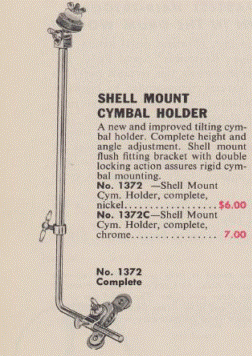
1962 LUDWIG CYMBAL MOUNTS

FLOOR TOM LEGS
The first floor tom toms were held in non-adjustable
“cradle” stands. Around 1938, Leedy introduced the
first floor tom legs. Even though Ludwig & Ludwig and Leedy
were essentially made under the same roof (both Conn-owned), Ludwig &
Ludwig did not offer floor tom legs until the late 1940’s. Slingerland
did not install floor tom legs on their drums until 1947.
VARIOUS CRADLE STANDS: 1930’s Ludwig
& Ludwig; 1936 Slingerland; 1940 Slingerland; 1943 Ludwig & Ludwig




LUDWIG & LUDWIG (1948)

EARLY LEG BRACKETS: 1938 Leedy on the left, 1947 Slingerland and Leedy (center),
and an unknown bracket- possibly a Slingerland
prototype (right).





When the
Ludwig & Ludwig company was sold to William F. Ludwig (W.F.L. Drum Co.) in
1956, the spring loaded W.F.L. leg brackets (“Clipper”) were used on their new
tom toms. By pushing on the tab, the spring pressure was released and the leg
could be moved vertically. Around 1962, a new style of bracket appeared which
was not spring loaded but instead employed a wing screw.
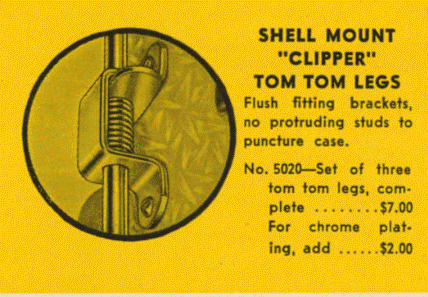
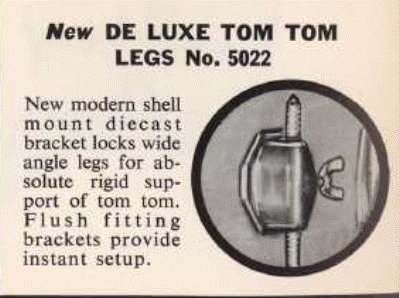
Slingerland used their simple floor tom leg brackets for almost ten years
until around 1958. That year, a new “teardrop” shaped bracket was introduced
which featured a push button control. Below is a catalog illustration of Slingerland’s recent innovations for 1958. The Leedy Drum Company, which was by now owned by Slingerland also used these brackets. By 1965, the push
button was replaced with a simple wing screw. A teardrop shaped cymbal mount
was also offered from 1958 on.

In 1962, Ludwig offered several mounts based around
their unique new bracket design.

FOOT PEDALS
Drum companies liked to express their ingenuity and the
foot pedal allowed them to do just that. Each company had their own unique foot
pedal designs ranging from the very practical to the bizarre. Here are several
examples of foot pedals throughout the years…
EARLY 1920’s LUDWIG PEDALS
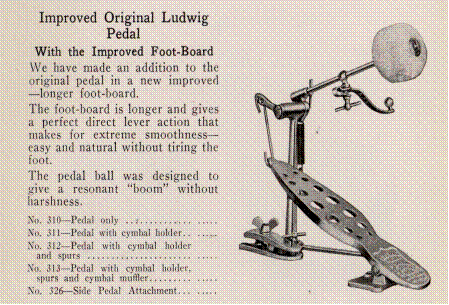
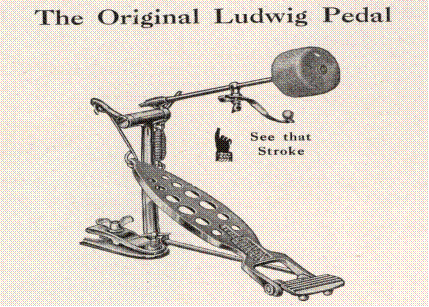
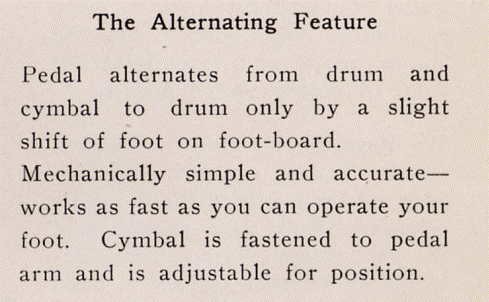
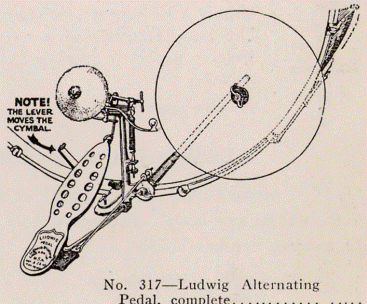
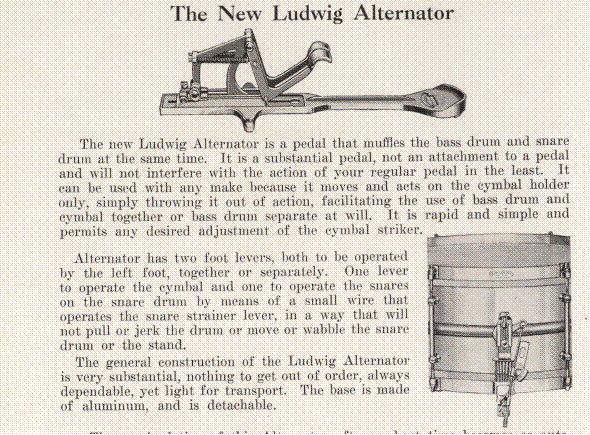

1929 LUDWIG & LUDWIG PEDALS


LUDWIG PEDALS 1935-1965


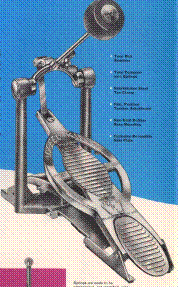
SLINGERLAND PEDALS
1930-1965






LEEDY ALTERNATING PEDAL (1928)

LEEDY PEDALS 1933



![]()
BADGES
Here are several examples of the various drum badges from 1923
through 1965. The dates listed are only approximate. In some cases, the date
represents the actual known date of the drum to which it is attached. It should
be noted that Slingerland did not install badges or
air vents on tom toms until 1963.
LUDWIG BADGES
1926-1934

1923-1934

1935-1945

1946-1950


1959-1960
1961-1963 1964-1969



S
SLINGERLAND BADGES
1926

1929

1935

1938

1944-1947
(These badges came in a few different trim colors)

1948-1951

1952-1954

1955-1957

1958-1962

1963-1969

LEEDY BADGES
1930-1934 1935-1937 1938-1946



1946-1948 1949-1950


1930’s BASS DRUM BADGES


1950-1954

1957-1962

1963-1970

![]()
WHERE’S THE BADGE?
Occasionally, “special order” drums
have been produced and this 1940’s Slingerland Radio
King drum may have been just that. This drum was made
without a badge or an air vent! Why anyone would want that is anyone’s guess.
Below are some photos of this odd snare drum….

 ’
’

![]()
BADGE PLACEMENT
Regarding Slingerland
badges and air vent grommets, badge placement should be mentioned. Slingerland snare drums had badges installed at different
locations over the years. One early snare drums (1928-1939), the badge was
usually installed to the left of the strainer. While there were undoubtedly
variations during this period, this placement was pretty consistent.



On snare drums from 1940-1941, the
badge was usually positioned to the left of the muffler.



After 1941, the badges were placed
in random positions with no apparent pattern or logic.









![]()
MISCELLANEOUS
Here are some interesting drum head images:
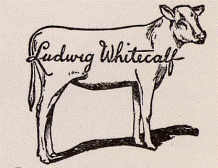
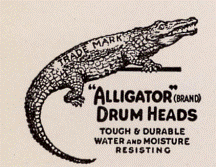
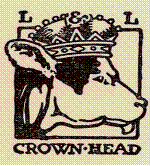

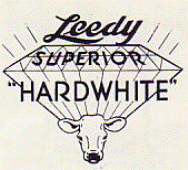
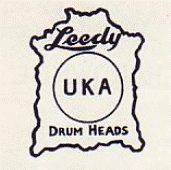
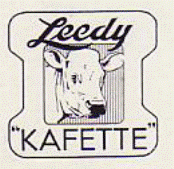
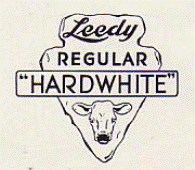
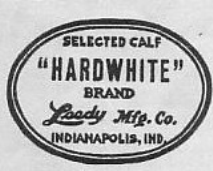
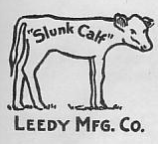
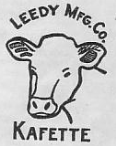
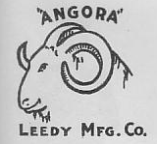
In the
1920’s and 1930’s, painted drum heads were quite popular. Drum companies
employed artists to apply artwork to bass drum heads at the factories. Drummers
could choose from a variety of colorful designs. Black and white paintings were
a less expensive option.
LEEDY PAINTED HEADS (1928)



LEEDY PAINTED HEADS (1929)


1929 LUDWIG & LUDWIG



Slingerland Painted
Heads (1934 catalog)

![]()
LUDWIG & LUDWIG AND LEEDY MUFFLERS AND INTERNAL TONE
CONTROLS
The first
tone controls or muffling devices were attached to snare drums and bass drums
externally on the hoops and appeared in the early 1930’s. Leedy
introduced an internal muffler or tone control for snare drums around 1934 that
was attached to the drum shell.
1934 LEEDY INTERNAL TONE CONTROL
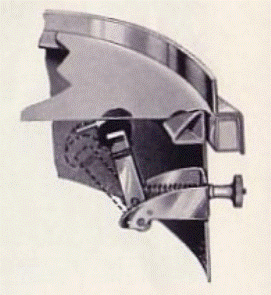
Around 1935, Leedy as well as Ludwig
& Ludwig were using a redesigned version of the tone control. This type was
used until around 1950. Leedy & Ludwig used this tone control until around
1952, when the version at right was introduced.


1956-1963
Ludwig tone control (left); 1964 controls (right)
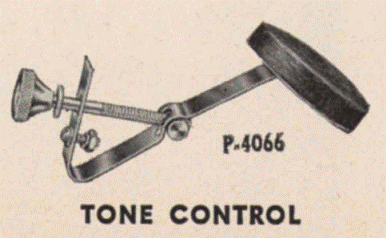

Slingerland began using internal tone controls in the early 1930’s.
Interestingly, the first version, named after its inventor, contained some of
the same parts that were used on the DuAll snare
strainer. This was used until around 1937, when a single green felt pad version
was introduced. This was followed around 1938 with a double red felt pad
version. Various colors have been used including yellow, red, green, gray, and
black. During World War Two and after, reddish gray pads were used along with a
fatter adjustment knob. By the end of the decade, the thick black pad version
was used until 1963. That year, a new single pad tone control was being
installed on snare drums and tom toms.


![]()
Below are the various tone controls in order of use
(1933-1965)






SLINGERLAND 1940’s BASS DRUM MUFFLER (L) and ADJUSTABLE
INTERNAL BASS MUFFLER (R)


INTERNAL HEATERS
From the 1920’s through the early 1960’s calf skin heads
were used on most drums. Because these heads were subject to changes in
humidity, this posed a problem for most drummers. When the humidity was high,
calf skin heads tended to become loose and unplayable. During periods of low
humidity and higher temperatures, the heads would become quite tight. To
maintain a consistent tension, internal electric heaters were often used. The
heaters were mounted on the drum shell and plugged into an electric outlet or
lamp socket. Light bulbs were also used,
mainly on bass drums. The bulbs served two purposes- they provided heat to deal
with humidity and they also provided back lighting for colorful bass drum
artwork. Often, blinking colored lights were used for extra effect.
LEEDY DRUM HEATER (1928)

BELOW: Light bulbs and fixtures
installed on bass drum shells


LEEDY ADVERTISEMENT (1928)

The photos below show the effects
of internal lighting.


![]()
FUN
PHOTOS
Here are a few interesting drum related images…















TO
CONTINUE OR RETURN TO ANY OTHER SECTION IN THIS GUIDE OR TO RETURN “HOME”, CLICK ON A LINK
BELOW…